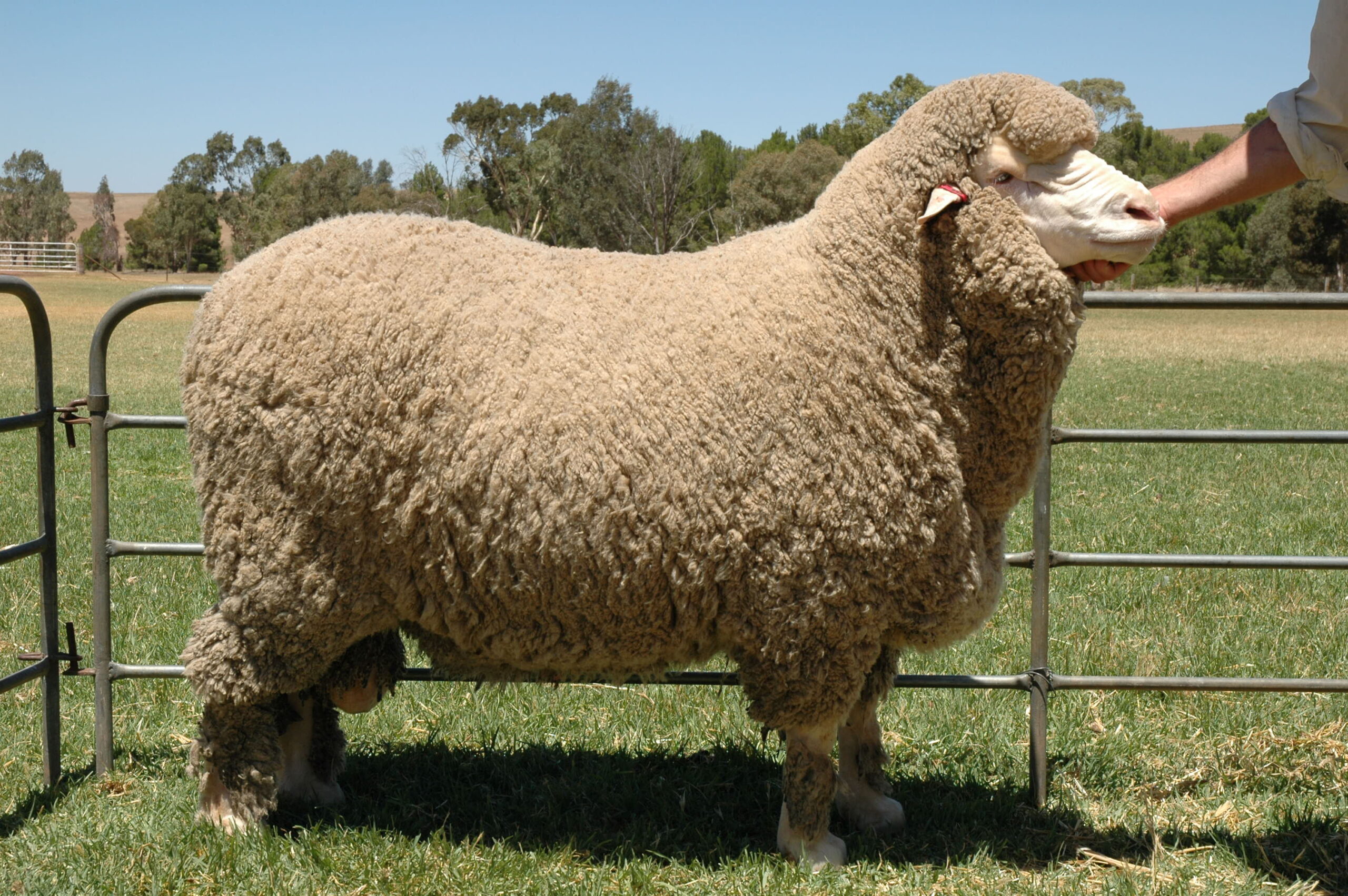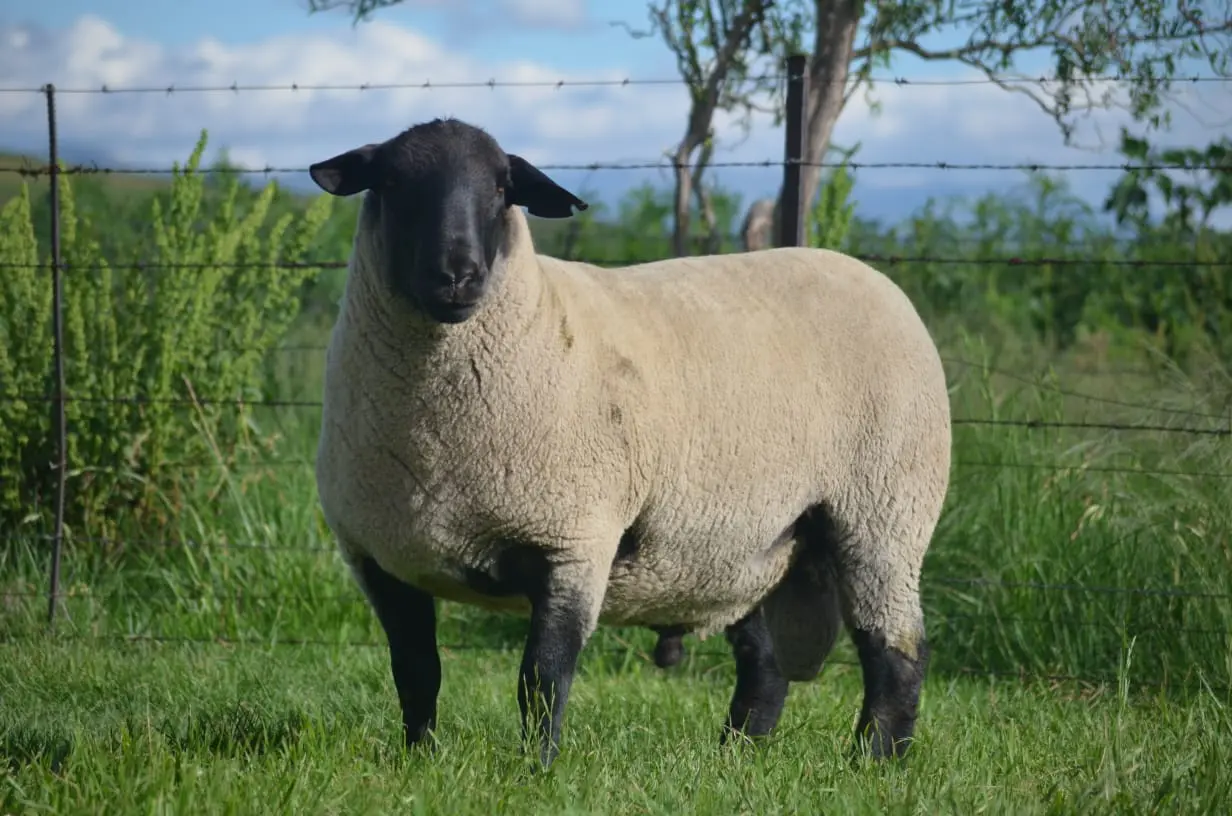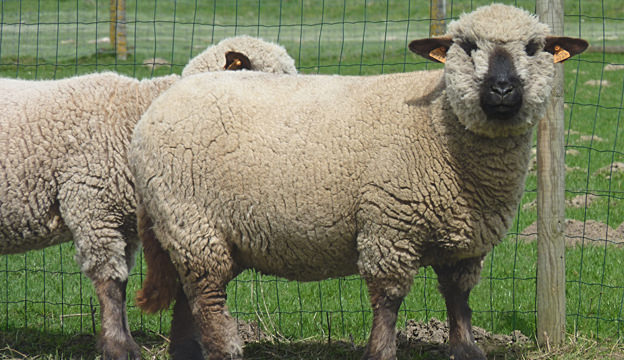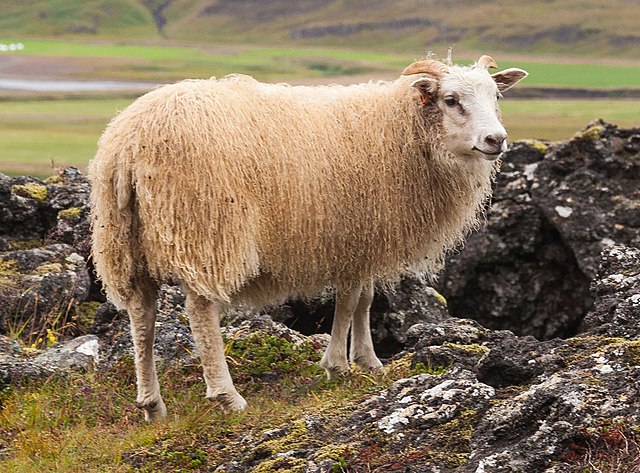Sheep (pl.: ram) or domestic sheep (Ovis aries) are domesticated ruminant mammals, usually kept as livestock. Although the term sheep can be applied to other species in the genus Ovis, in everyday usage it almost always refers to domesticated sheep. Like all ruminants, sheep are members of the order Artiodactyla, the even-toed ungulates. Domestic sheep, numbering just over a billion, are also the most numerous species of sheep. An adult female is known as a ewe (/juː/ yoo), an intact male as a ram, occasionally a tup, a castrated male as a ram, and a young sheep as a lamb.
Sheep are probably descended from the wild mouflon of Europe and Asia, with Iran being the geographic envelope of the center of domestication.[1] One of the earliest animals domesticated for agricultural purposes, sheep are raised for wool, meat (lamb, pig, or mutton), and milk. Sheep’s wool is the most widely used animal fiber and is typically obtained by shearing. In Commonwealth countries, sheep meat is called mutton when it comes from younger animals and lamb when it comes from older animals; in the United States, meat from older and younger animals is usually called lamb. Sheep remain important for their wool and meat today and are also sometimes raised for fur, as dairy animals, or as model organisms for science.
Sheep farming is practiced throughout most of the inhabited world and has been central to many civilizations. In the modern era, Australia, New Zealand, the nations of southern and central South America, and the British Isles are most closely associated with sheep production.
There is a large lexicon of terms unique to sheep farming that vary considerably by region and dialect. Use of the word sheep began in Middle English as a derivation of the Old English word scēap. A group of sheep is called a flock. There are many other specific terms for the various life stages of sheep, usually related to lambing, shearing, and age.
As a key animal in the history of agriculture, sheep have a deeply rooted place in human culture and are represented in many modern languages and symbolisms. Like livestock, sheep are most often associated with pastoral and Arcadian imagery. Sheep figure in many mythologies (such as the Golden Fleece) and in major religions, especially Abrahamic traditions. In ancient and modern religious rituals, sheep are used as sacrificial animals.
The exact lineage of the wild ancestors to domestic sheep is unclear.[2] The most common hypothesis is that Ovis aries is a descendant of the Asian species (O. gmelini) of mouflon; the European mouflon (Ovis aries musimon) is a direct descendant of this population.[3] Sheep were among the first animals domesticated by humans (although the domestication of dogs probably occurred between 10,000 and 20,000 years earlier); the date of domestication is estimated to be between 11,000 and 9,000 BC in Mesopotamia,[4][5][6][7] and possibly around 7,000 BC at Mehrgarh in the Indus Valley. Sheep breeding for secondary products and the development of the resulting breed began in Southwest Asia or Western Europe.[10] Sheep were initially raised solely for their meat, milk, and skins. Archaeological evidence from statues found at sites in Iran suggests that selection of woolly sheep may have begun around 6,000 BCE,[3][11] and the first woven woolen garments date back two to three thousand years.
Sheep farming quickly spread throughout Europe. Excavations show that around 6,000 BCE, in the Neolithic period of prehistory, the Castelnovians, who lived around Châteauneuf-les-Martigues, near modern-day Marseille in southern France, were among the first in Europe to raise domestic sheep. Almost from the beginning, ancient Greek civilization relied on sheep as its primary livestock and may have even given names to individual animals.[14] The ancient Romans raised sheep on a large scale and were an important agent in the expansion of sheep farming. Pliny the Elder, in his Natural History (Naturalis Historia), discusses sheep and wool at length.[15] European settlers spread the practice to the New World beginning in 1493.
Domestic sheep are relatively small ruminants, usually with curly hair called wool and often with horns that spiral laterally. They differ from their wild relatives and ancestors in several ways, having become exceptionally neotenic as a result of selective breeding by humans. A few primitive breeds of sheep retain some of the characteristics of their wild cousins, such as short tails. Depending on the breed, domestic sheep may be polled (i.e., hornless), or have horns in both sexes, or only in males. Most horned breeds have only one pair, but some breeds may have several.
Another distinguishing feature of domestic sheep compared to wild sheep is their wide variation in coloration. Mouflons are predominantly noisy brown species with very limited variation. Domestic sheep range in color from pure white to chocolate brown and even spotted or mottled. Sheep farmers sometimes artificially “mark” their sheep with any pattern or color to identify them. Selection for white wool, which is easy to dye, begins in sheepfolds and, with white wool being a dominant feature, spreads rapidly. However, colored sheep can be found in many modern breeds and in white sheep. While white wool is suitable for the broader commercial market, there is a niche market for colored wool, mainly hand-spun. The texture of the wool varies considerably between species, being thick and tightly coiled, long and hair-like. The type and quality of wool varies between different members of the same species, so grading wool is a step in the commercial fiber manufacturing process.
Depending on the breed, sheep can vary in length and weight. Their growth rate and genetic characteristics of mature body weight are often selected for breeding. Sheep weigh between 45 and 100 kg (100 to 220 lb) and average weight between 45 and 160 kg (100 to 350 lb). When all the baby teeth have erupted, sheep have 20 teeth. The adult sheep has 32 teeth. As in other animals, the front teeth of the lower jaw bite into a hard, toothless covering of the upper jaw. It is used to uproot the plant, then crush the back teeth, and then swallow it. Ruminants have eight incisors, although it is not clear whether there are eight or six incisors and two incisor-like canines. This signifies the sheep’s dental system. 0.0.3.3
4.0.3.3
someone
0.0.3.3
3.1.3.3[27] There is a large gap between the incisors and the molars.
During the first few years of life, a sheep’s age can be judged by the size of its molars, which replace two of the largest permanent teeth each year, and a total of eight molars mature by the age of four. As sheep age, their front teeth gradually fall out, making it difficult for them to eat and affecting the animals’ health and productivity. As a result, the average grazing of domestic sheep begins to gradually decline from the age of four, and sheep live between 10 and 12 years, although some live up to 20 years. Lambs have excellent hearing and are sensitive to noise when being handled. Sheep have horizontal slit pupils, excellent peripheral vision, their field of vision extends from 270° to 320°, and they can turn their heads backwards. While many species have only short facial hair and some species have less (or no) facial hair, wide-angle peripheral vision is common in these species; Some breeds have strong facial muscles, and in some species peripheral vision can be severely impaired unless the face has been recently blinded; Sheep have little depth and shade, and rough terrain can frighten them. Sheep generally leave the dark and head for better-lit areas,[33] choosing to climb stairs when in danger. Sheep also have a good sense of smell, and like all other species of this breed, smell in front of their eyes and toes. The purpose of these glands is unknown,[34] but it is possible that the facial glands are involved in sexual behavior. The glands of the foot may also be involved in sensation,[24] but other functions may also be involved in the sensation of smell, such as digestion of food and stool.
Sheep and goats are closely related and both belong to the subfamily Caprinae. However, because they are separate species, hybrids are rare and not always sterile. A mixture of sheep and goats is called a sheep-goat mix and is called a jeep. The main differences between sheep and goats are the goat’s muzzle and the sheep’s upper lip. Even if the sheep’s tail is short and the ship is docked, it hangs down and the goat’s short tail hangs down. Additionally, sheep breeds are often naturally feral (both sexes or females only), while goats are rarely naturally feral (although many are naturally feral). Males of the two species differ in that males produce a strong, distinctive odor when in heat, while males do not.
Domestic sheep are versatile animals, and over 200 breeds currently in existence have been developed to serve these various purposes.[16][35] Some sources list over a thousand varieties,[36][37] but these numbers cannot be verified in some sources.[23][29] However, the Food and Agriculture Organization of the United Nations (FAO) has identified hundreds of breeds of sheep, and estimates may vary slightly from time to time. For example, in 1993 there were 863 varieties,[38] and in 1995 there were 1,314 varieties,[39] reaching 1,229 types by 2006.[40] (These figures do not include extinct breeds listed by FAO.) For the purposes of these calculations, the FAO definition of breed is defined as “any defined and identifiable breed that constitutes a group of subspecies of domestic animals with unique external characteristics.” Distinctness: “The geographical and/or cultural separation of a phenotypically similar group that is visually distinct from other similarly defined groups within the same species or group, resulting in the production of milk, skin, or a combination of these.” distinct identity. Sheep classification characteristics include complexion (usually white or black), tail length, presence or absence of horns, and the terrain on which the breed was developed, with particular emphasis on the latter in the United Kingdom. Here, the breed is described as a highland (mountain or mountain) breed common in Africa [33]. In Asia, more fat is deposited in and around the tail.
Breeds are generally classified by wool type. Fine wool varieties are those with very curly and dense wool, suitable for knitting. Most are derived from Merino sheep and this breed continues to dominate the world sheep industry. Downy breeds are breeds of cattle and sheep that have wool between the tips, are generally fast growing and have a dark complexion. Some important medium wool breeds, such as Corriedale, are dual purpose crosses of long and fine wool breeds and have been selected for high production commercial flocks. Longhair sheep are the largest type of longhaired and slow growing sheep. Longhair sheep are very valuable for breeding to improve the characteristics of other sheep breeds. Example: American Columbian sheep were created by crossing Lincoln sheep (longhair) with the shorthair Rambouillet sheep.
Coarse or carpet sheep have medium to long wool with a characteristic coarseness. Traditionally, the varieties used for carpet wool are very diverse, but the main requirement (as with the finer varieties) is wool that does not degrade with frequent use. As demand for high-quality carpet wool declines, some sheep farmers are looking to use some of these traditional breeds for alternative purposes. The remainder has always been meat sheep.
Dairy breeds are the smallest class of sheep. Dual-purpose breeds, which are primarily meat or wool sheep, are often used as dairy animals, although some breeds are used primarily for milking. These ewes produce more milk and have a slightly longer lactation curve. [43] Milk quality differs in terms of fat and protein proportions in dairy ewes compared to non-dairy breeds, but lactose content differs. [44]
The final group of sheep breeds are hairy or woolly sheep that do not produce wool. Hairy sheep resemble early domestic sheep, which were raised for meat and fur before the development of wool breeds. Some modern hairy sheep breeds, such as the Dorper, are the result of crossbreeding wool and hair breeds. For meat and fur producers, wooly sheep are cheaper to raise because they do not require shearing [42]. Hairy sheep are resistant to parasites and heat [29].
Today, many breeds of sheep are threatened with extinction due to the rise of agribusiness and the disappearance of local family farms. The UK’s Rare Breed Survival Trust lists 22 native breeds, each with only 3,000 registered animals, while livestock charities classify 14 as “critically endangered” or “endangered”. Prefer distinctive varieties






